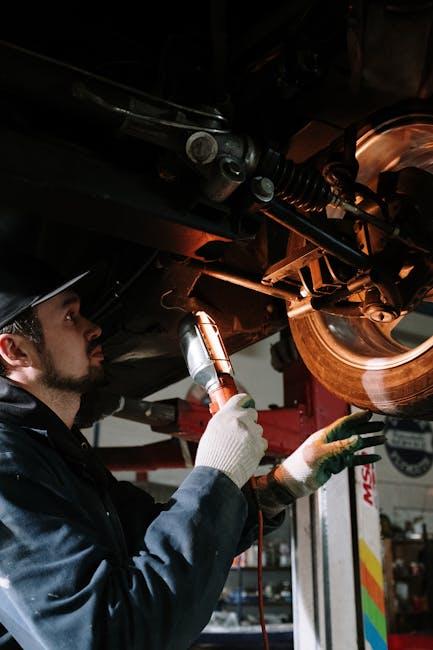In the intricate dance of automotive components, ball joints play a pivotal role, quietly enabling smooth steering and suspension movement. Often overlooked until a problem arises, these small yet essential parts deserve a closer look to ensure your vehicle’s safety and performance. Knowing how to check ball joints not only helps prevent costly repairs but also gives you a deeper understanding of your car’s inner workings. In this guide, we’ll explore practical steps for assessing ball joint condition, empowering you to spot issues before they escalate. Whether you’re a seasoned gearhead or a curious newcomer, mastering this skill can keep your ride steady and secure on the road ahead.
Table of Contents
- Understanding the Role of Ball Joints in Vehicle Suspension
- Identifying Common Symptoms of Worn Ball Joints
- Essential Tools Required for Ball Joint Inspection
- Step-by-Step Procedure for a Visual and Physical Ball Joint Check
- Interpreting Inspection Results and Knowing When to Replace
- Safety Tips and Maintenance Recommendations for Longevity
- Q&A
- In Conclusion

Understanding the Role of Ball Joints in Vehicle Suspension
Ball joints serve as pivotal connectors between the vehicle’s control arms and steering knuckles, granting the suspension system the ability to move and steer smoothly. These spherical bearings absorb shocks from the road while maintaining precise wheel alignment, ensuring both safety and comfort during driving. Without properly functioning ball joints, your vehicle’s handling would become unpredictable, causing uneven tire wear and potentially hazardous driving conditions. They are essential for maintaining the correct geometry of the suspension system as the vehicle navigates varied surfaces.
When inspecting ball joints, consider looking for these key indicators of wear or failure:
- Excessive play: Movement beyond manufacturer specifications can indicate looseness.
- Uneven tire wear: Premature or irregular tread wear often signals suspension issues.
- Noise: Clunking or squeaking sounds when going over bumps suggest worn joints.
- Visual damage: Cracked or torn rubber boots expose the joint to contaminants.
| Inspection Aspect | Signs of Wear | Potential Consequences |
|---|---|---|
| Ball joint movement | Excessive looseness or binding | Steering instability |
| Rubber boot condition | Cracks or tears | Grease leakage, contamination |
| Noise during driving | Clunking or squeaking sounds | Wheel misalignment |

Identifying Common Symptoms of Worn Ball Joints
When ball joints begin to wear out, your vehicle often sends subtle but clear signals that shouldn’t be ignored. You might notice a clunking noise coming from the front suspension when driving over bumps or during sharp turns. Another common symptom is uneven tire wear, especially on the inside or outside edges of the tires, indicating that the alignment is off due to ball joint looseness. Additionally, a feeling of vibration or wandering in the steering wheel, particularly at higher speeds, can point to a failing ball joint that’s affecting your vehicle’s stability.
Physical signs often accompany these driving symptoms. For example, if you inspect your front wheels and notice excessive play or movement when shaking the wheel at the 12 and 6 o’clock positions, this can be a warning sign. Below is a quick reference to understand the typical signs you might encounter:
| Symptom | What It Means | Urgency |
|---|---|---|
| Clunking Noise | Worn ball joint causing metal-on-metal contact | High |
| Uneven Tire Wear | Misalignment due to loose ball joints | Medium |
| Steering Wheel Vibration | Degraded stability from joint looseness | Medium |
| Excessive Wheel Play | Direct indicator of ball joint wear | High |

Essential Tools Required for Ball Joint Inspection
Before you dive into inspecting ball joints, it’s crucial to arm yourself with the right set of tools. These tools not only make the job more efficient but also ensure that you get accurate assessments without any guesswork. At the core, you’ll need a sturdy jack and jack stands to safely lift and secure the vehicle, allowing unrestricted access to the suspension components. A reliable socket set is essential for removing any bolts and securing parts, paired with a breaker bar to tackle stubborn fasteners. Complement these with a ball joint separator; this handy component makes detaching the ball joint from the suspension easier and prevents damage to other parts.
Precision tools elevate the inspection to another level. A dial indicator gauge will let you measure play or movement in the ball joint, revealing wear that’s not visible to the naked eye. To pinpoint wear points or cracks, a flashlight or a handy inspection mirror can be invaluable. Lastly, don’t forget the basics: work gloves to protect your hands and a mechanic’s creeper for comfort while working under the vehicle. Below is a quick reference table summarizing these essentials:
| Tool | Purpose |
|---|---|
| Jack & Jack Stands | Safe vehicle lifting and securing |
| Socket Set & Breaker Bar | Removing fasteners and bolts |
| Ball Joint Separator | Detaching ball joints cleanly |
| Dial Indicator Gauge | Measuring ball joint play |
| Flashlight / Inspection Mirror | Visual inspection of wear and damage |
| Work Gloves & Mechanic’s Creeper | Hand protection and comfort |

Step-by-Step Procedure for a Visual and Physical Ball Joint Check
Begin by visually inspecting the ball joints for any signs of wear, corrosion, or torn protective boots. Use a flashlight to check for grease leakage around the joint which often indicates damage. Look closely for unusual rust spots, cracks, or broken parts that might affect the ball joint’s functionality. In addition, examine the surrounding suspension components to spot any indirect signs of ball joint stress, such as uneven tire wear or misalignment.
For the physical check, elevate the vehicle using a jack and make sure it’s securely supported with jack stands. Grab the tire at the 12 o’clock and 6 o’clock positions and try to rock it back and forth. Any excessive play or knocking noise may suggest a worn ball joint. Alternatively, use a pry bar to gently lift the control arm near the ball joint and observe for movement at the joint itself. If movement is detected, it’s time to replace the ball joint to maintain safety and optimal vehicle performance.

Interpreting Inspection Results and Knowing When to Replace
Once you’ve completed your ball joint inspection, it’s crucial to understand what the results signify. If you notice any visible rust, cracks, or excessive grease leakage, these are tell-tale signs that the ball joint is compromised. Additionally, when you detect noticeable play or looseness during a physical test, it often means the ball joint’s internal components are worn out, which can severely affect your vehicle’s handling and safety. Small wear may be tolerable for a short period, but any audible clicking or clunking noises, especially when turning or going over bumps, should be taken seriously.
Knowing exactly when to replace your ball joints can save you from costly repairs down the road. Use the following quick-reference guide to evaluate your findings:
| Inspection Result | Recommended Action |
|---|---|
| Minimal Looseness & No Noise | Monitor Routinely |
| Visible Wear, Rust, or Leakage | Schedule Replacement Soon |
| Excessive Movement or Clunking Sound | Replace Immediately |
- Safety first: If in doubt, err on the side of caution and consult a professional.
- Consistency counts: Check your ball joints regularly to detect deterioration early.
- Follow vehicle specs: Refer to your manufacturer’s recommended replacement intervals.

Safety Tips and Maintenance Recommendations for Longevity
Ensuring the safety of your vehicle starts with regular inspection and diligent maintenance of vital components like ball joints. Always begin by performing a visual check for signs of wear such as torn rubber boots, rust, or grease leakage. These early indicators suggest that dirt and moisture may have compromised the joint, increasing the risk of failure. When checking, use proper tools and avoid working under a vehicle without secure lift support. Keep in mind personal protective equipment such as gloves and safety glasses to prevent injury during inspection or repairs.
Extending the lifespan of ball joints also involves following manufacturer-recommended maintenance schedules and lubrication routines. Avoid aggressive driving on rough terrain, which accelerates wear. Regularly grease the joints if your vehicle design allows, as lubrication minimizes friction and heat buildup. The table below highlights basic maintenance tips with their corresponding benefits:
| Maintenance Tip | Benefit |
|---|---|
| Inspect boots for cracks | Prevents contamination |
| Grease at intervals | Reduces joint wear |
| Avoid harsh terrain | Minimizes stress on joints |
| Secure proper lifting | Ensures technician safety |
Q&A
Q: What are ball joints, and why are they important?
A: Ball joints are crucial components of your vehicle’s suspension system. They act like a flexible pivot connecting the control arms to the steering knuckles, allowing for smooth movement and steering. Without healthy ball joints, your driving experience can become unsafe and uncomfortable.
Q: How can I tell if my ball joints need checking?
A: Common warning signs include unusual clunking noises when going over bumps, uneven tire wear, or a wandering steering wheel. If your car feels loose or unstable around corners, it’s time to take a closer look at those ball joints.
Q: What tools do I need to check ball joints at home?
A: You don’t need a full mechanic’s toolkit. A jack and jack stands to lift and secure the vehicle, a pry bar or a sturdy lever, and perhaps a flashlight for visibility are the essentials. A helper to assist in moving the steering wheel or suspension might come in handy.
Q: What’s the basic process for checking ball joints?
A: First, safely lift the vehicle and remove the wheel. Then, inspect the rubber boots around the ball joint for cracks or tears. Use the pry bar to gently lift the control arm or steering knuckle to see if there’s excessive movement or play in the ball joint. Any looseness indicates wear or failure.
Q: Can I rely solely on a visual inspection?
A: Visual inspection is a great first step, especially checking for torn boots that let dirt in, but it’s not enough. Ball joints can look fine on the outside while being worn internally. The “play” test by hand or with a pry bar is critical to catch subtle issues.
Q: How often should ball joints be checked?
A: Ideally, check them during routine maintenance every 12,000 miles or once a year. If you drive on rough roads or off-road frequently, inspect them more often. Early detection can prevent costly repairs and accidents.
Q: What should I do if I find worn or damaged ball joints?
A: Replacing ball joints is often not a DIY job unless you have proper tools and experience. It’s wise to consult a professional mechanic who can safely replace the parts and realign your vehicle for optimal performance.
Q: Are all ball joints the same across vehicles?
A: Not quite. Ball joints vary by vehicle make and model in size, design, and whether they are serviceable or integrated into control arms. Always refer to your vehicle’s manual or parts specifications when inspecting or replacing them.
Q: Can worn ball joints affect vehicle safety?
A: Absolutely. Compromised ball joints can lead to poor handling, steering instability, and in severe cases, suspension collapse—posing serious safety risks. Regular checks keep you safe on every journey.
Q: In summary, what’s the takeaway about checking ball joints?
A: Stay proactive! Regular inspection, knowing the signs of wear, and timely replacement keep your suspension smooth and your driving safe. Your vehicle’s ball joints might be small, but their role is huge.
In Conclusion
In the ever-turning world of automotive care, knowing how to check ball joints is a skill that puts you one step ahead of unexpected breakdowns. These small but mighty components play a crucial role in your vehicle’s safety and performance, quietly bearing the weight of every twist and turn. By taking the time to inspect and maintain your ball joints, you’re not just preserving your car’s ride quality—you’re safeguarding your peace of mind on every journey. So next time you hear a clunk or feel a wobble, remember: a little attention today can keep your wheels rolling smoothly tomorrow.

